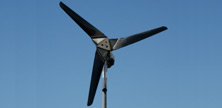Wind Turbines

Generate electricity at home with small-scale wind turbines
Wind turbines harness the power of the wind and use it to generate electricity. Small systems known as "microwind" turbines can produce enough electricity for the lights and electrical appliances in a typical home.
40% of all the wind energy in Europe blows over the UK, making it an ideal country for microwind turbines.
- How do microwind turbines work?
- The benefits of wind electricity
How do wind turbines work?
Wind turbines use large blades to catch the wind. When the wind blows the blades are forced round, driving a turbine which generates electricity. The stronger the wind, the more electricity produced.
There are two types of domestic-sized microwind turbine:
- Mast mounted: these are free standing and are erected in a suitably exposed position.
- Roof mounted: these are smaller than mast mounted systems and can be installed on the roof of a home.
If your microwind system is connected to the National Grid then you can make money by selling any generated electricity to an electricity supply company.
If the turbine is not connected to the electricity grid then unused electricity can be stored in a battery for use when there is no wind.
In the UK we have 40% of Europe's total wind energy

The benefits of wind electricity
- Harness a plentiful energy source: in the UK we have 40% of Europe's total wind energy.
- Cut your carbon footprint: wind electricity is green, renewable energy and doesn't release any harmful carbon dioxide or other pollutants.
- Cut your electricity bills: wind is free, so once you've paid for the initial installation your electricity costs will be reduced.
Store electricity for a calm day: if your home isn't connected to the National Grid you can store excess electricity in batteries and use it when there is no wind. |


